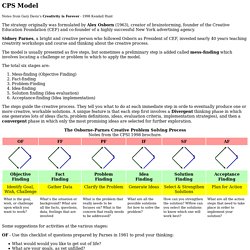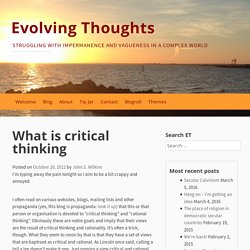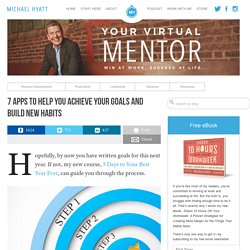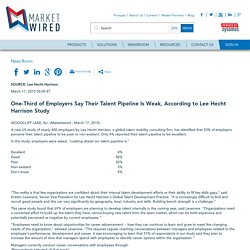

CPS (Creative Problem Solving) model. Notes from Gary Davis's Creativity is Forever - 1998 Kendall Hunt The strategy originally was formulated by Alex Osborn (1963), creator of brainstorming, founder of the Creative Education Foundation (CEF) and co-founder of a highly successful New York advertising agency.

Sidney Parnes, a bright and creative person who followed Osborn as President of CEF, invested nearly 40 years teaching creativity workshops and course and thinking about the creative process. The model is usually presented as five steps, but sometimes a preliminary step is added called mess-finding which involves locating a challenge or problem to which to apply the model. The total six stages are: Mess-finding (Objective Finding) Fact-finding Problem-Finding Idea-finding Solution finding (Idea evaluation) Acceptance-finding (Idea implementation) The steps guide the creative process.
The Osborne-Parnes Creative Problem Solving Process Notes from the CPSI 1998 brochure. Some suggestions for activities at the various stages: What is critical thinking. I’m typing away the pain tonight so I aim to be a bit crappy and annoyed.

I often read on various websites, blogs, mailing lists and other propaganda (yes, this blog is propaganda: look it up) that this or that person or organisation is devoted to “critical thinking” and “rational thinking”. Obviously these are noble goals and imply that their views are the result of critical thinking and rationality. It’s often a trick, though.
7 Apps to Help You Achieve Your Goals and Build New Habits. Hopefully, by now you have written goals for this next year.

If not, my new course, 5 Days to Your Best Year Ever, can guide you through the process. Photo courtesy of Shutterstock/Lonely But as much as I believe in having a set of written goals, it is not enough. You have to take action and then systematically measure your progress. Fortunately, there are numerous apps designed for just this purpose. Recently, I went on a search to find an app for my own use. Goal: “Something you are trying to achieve.” Some applications track all of these items. I have not reviewed each of these extensively. Nozbe: Strictly speaking, this is a task management app. IrunurunYou begin by entering the action or habit you want to track.
Will you find the perfect app? One-Third of Employers Say Their Talent Pipeline Is Weak, According to Lee Hecht Harrison Study. SOURCE: Lee Hecht Harrison WOODCLIFF LAKE, NJ--(Marketwired - March 17, 2015) - A new US study of nearly 400 employers by Lee Hecht Harrison, a global talent mobility consulting firm, has identified that 33% of employers perceive their talent pipeline to be poor or non-existent.

Only 4% reported their talent pipeline to be excellent. In the study, employers were asked, "Looking ahead our talent pipeline is:" "The reality is that few organizations are confident about their internal talent development efforts or their ability to fill key skills gaps," said Kristen Leverone, Senior Vice President for Lee Hecht Harrison's Global Talent Development Practice. This same study found that 69% of employers are planning to develop talent internally in the coming year, said Leverone. "Employees need to know about opportunities for career advancement -- how they can continue to learn and grow to meet the changing needs of the organization," advised Leverone.
About the Study. ICF Approved Power Coach Training Programs for Mind.
Publishing. Academic conferences worldwide - Conference Alerts. Personal Branding. Emotional Intelligence. Why Walmart Is Like a Forest. The story of Wal-Mart Stores Inc.’s growth from a chain of small, rural discount stores to its current position as the world’s largest retailer and private employer is the stuff of business legend.

Analysts cite numerous reasons for the company’s growth, ranging from its logistical prowess and the entrepreneurial genius of founder Sam Walton to predatory pricing and the abuse of labor laws. But a cause of Walmart’s success that one rarely sees advanced is that of the firm’s roots in rural Arkansas, and the disciplines imposed on the fledgling business by that challenging context. To understand this, it’s helpful to think of Walmart as an ecosystem, like a forest, and track the company’s growth from its small beginnings to large-scale maturity.
In addition, the forest analogy gives us insight into the process of organizational renewal — a challenge that faces many corporations and institutions in the West. You can see the same dynamics at work in Walmart’s early years.
People Performance. Quotes. Personal Success. Culture and Change.